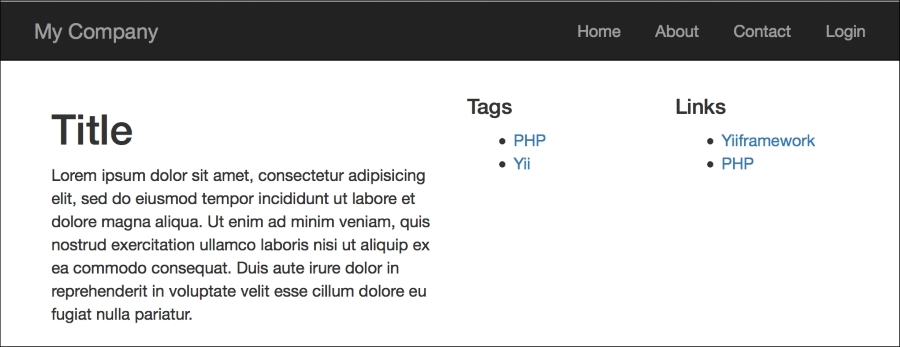Most applications use a single layout for all their views. However, there are situations when multiple layouts are needed. For example, an application can use different layouts on different pages: two additional columns for blogs, one additional column for articles, and no additional columns for portfolios.
Create a new application using the Composer package manager, as described in the official guide at http://www.yiiframework.com/doc-2.0/guide-startinstallation.html.
- Create two layouts in views/layouts:
blogandarticles. Blog will contain the following code:<?php $this->beginContent('//layouts/main')?> <div> <?= $content ?> </div> <div class="sidebar tags"> <ul> <li><a href="#php">PHP</a></li> <li><a href="#yii">Yii</a></li> </ul> </div> <div class="sidebar links"> <ul> <li><a href="http://yiiframework.com/"> Yiiframework</a></li> <li><a href="http://php.net/">PHP</a></li> </ul> </div> <?php $this->endContent()?> - Articles will contain the following code:
<?php /* @var $this yiiwebView */ ?> <?php $this->beginContent('@app/views/layouts/main.php'); ?> <div class="container"> <div class="col-xs-8"> <?= $content ?> </div> <div class="col-xs-4"> <h4>Table of contents</h4> <ol> <li><a href="#intro">Introduction</a></li> <li><a href="#quick-start">Quick start</a></li> <li>..</li> </ol> </div> </div> <?php $this->endContent() ?> - Create a view file,
views/site/content.php, as follows:<h1>Title</h1> <p>Lorem ipsum dolor sit amet, consectetur adipisicing elit, sed do eiusmod tempor incididunt ut labore et dolore magna aliqua. Ut enim ad minim veniam, quis nostrud exercitation ullamco laboris nisi ut aliquip ex ea commodo consequat. Duis aute irure dolor in reprehenderit in voluptate velit esse cillum dolore eu fugiat nulla pariatur.</p>
- Create three controllers named
BlogController,ArticleController, andPortfolioController, with index actions in all three. The content of thecontrollers/BlogController.phpfile is as follows:<?php namespace appcontrollers; use yiiwebController; class BlogController extends Controller { public $layout = 'blog'; public function actionIndex() { return $this->render('//site/content'); } } - The content of the
controllers/ArticleController.phpfile is as follows:<?php namespace appcontrollers; use yiiwebController; class ArticleController extends Controller { public $layout = 'articles'; public function actionIndex() { return $this->render('//site/content'); } } - The content of the
controllers/PortfolioController.phpfile is as follows:<?php namespace appcontrollers; use yiiwebController; class PortfolioController extends Controller { public function actionIndex() { return $this->render('//site/content'); } } - Now try running
http://yii-book.app/?r=blog/index:
- Then try running
http://yii-book.app/?r=article/index:
- Finally, try running
http://yii-book.app/?r=portfolio/index:
We defined two additional layouts for the blog and articles. As we don't want to copy and paste common parts from the main layout, we apply additional layout decorators using $this->beginContent and $this->endContent.
So, we use a view rendered inside the articles layout as the main layout's $content.
- The http://www.yiiframework.com/doc-2.0/guide-structure-views.html#nested-layouts URL provides more details about layouts.
- The Using the controller context in a view recipe
- The Using decorators recipe
